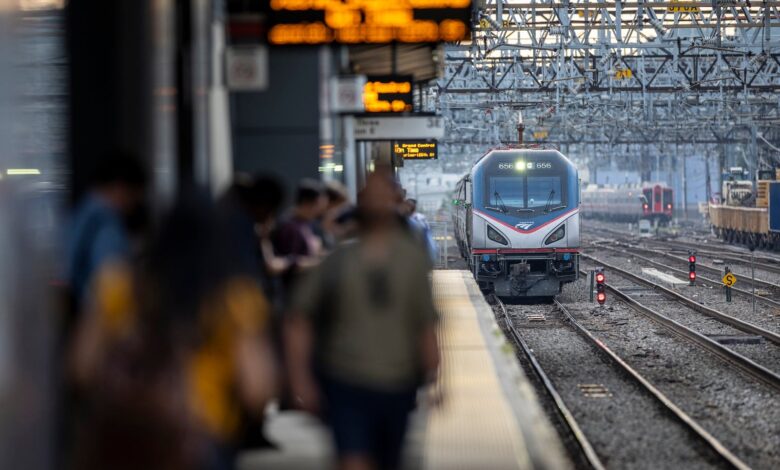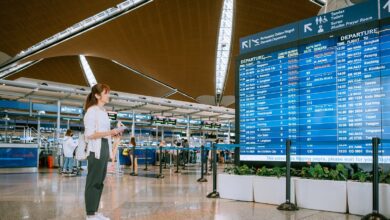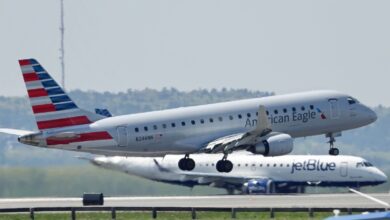Helped by federal funds and private investment, a major push for passenger rail

It’s the question rail enthusiasts have posed for years: When might U.S. train travel start to more closely resemble that of Europe and Asia?
When you travel overseas, it becomes only natural to ask.
In recent visits to Europe, I’ve seen the ease of the continent’s train travel firsthand. There’s the convenience of traveling from London Gatwick Airport (LGW) to the Tube via the Gatwick Express — a similar concept, itself, to the Heathrow Express that connects London travelers to Heathrow Airport (LHR).
You can take a 186 mph ride on a Renfe train in Spain.
There is likewise an astonishing array of rail itinerary options in Italy, such as a brisk, two-hour ride between Venice and Florence.
Yet, past years have brought travelers plenty of reasons to be pessimistic about rail travel in the U.S.
Frustration points range from the seemingly endless hurdles — not to mention billions of dollars lost — on California’s long-planned ‘bullet train’ to operational challenges and financial losses at Amtrak, and worn-out, century-old bridges and tunnels (not to mention delays) along the critical Northeast Corridor.
However, these days, there are signs of an American train travel renaissance — one Rep. Donald Payne, Jr., D-N.J., likened to “the beginning of the interstate highway system” during a June congressional hearing.
“I really think we’re on the cusp of a new era for passenger rail,” Laura Mason, Amtrak’s executive vice president for capital delivery, echoed in a recent interview with TPG.

Daily Newsletter
Reward your inbox with the TPG Daily newsletter
Join over 700,000 readers for breaking news, in-depth guides and exclusive deals from TPG’s experts
“I think all the indicators are going in the right direction,” Mason said.
A massive federal funding push for rail
The boost passenger rail has gotten from the White House in recent years is as profound as it is fitting. For decades, President Joe Biden was known for riding Amtrak to Washington, D.C., from his home in Wilmington, Delaware.
The 2021 bipartisan infrastructure law (passed by Congress and signed by the president) doled out $66 billion for rail — including a haul of money for Amtrak greater than every dollar the federally funded rail company had previously received in its half-century of existence.
In recent weeks, the effects the law will have on rail became clearer.
In early November, the White House announced more than $16 billion in grants aimed at transforming the Northeast Corridor — far and away Amtrak’s busiest for rail, which runs between Washington and Boston via Philadelphia and New York. It hosts more than 2,200 trains and 800,000 passengers daily.
The grant money will support the construction of two new tunnels under the Hudson River, relieving congestion to and from New York’s Penn Station.
A total of $4.7 billion will fund the construction of a new Frederick Douglass Tunnel in Baltimore — allowing trains to dramatically increase speed, alleviating traffic jams that have been common for years. The Baltimore “chokepoint,” Biden said, contributed to 12,000 minutes of delays in 2020 and frequently leads to disruptions up and down the East Coast.
Additional federal grants will fund improvements, expansion and new stations for the New York subway system. There’s money for new bridges in Maryland. Infrastructure dollars will help Amtrak straighten out curves and improve technical aspects of the Northeast Corridor, making it possible for trains to move faster.
And the huge haul of money the federal government is pouring into rail over the coming years follows plenty of other signs of momentum for American rail seen in recent years.
In 2021, for instance, Amtrak opened its new Moynihan Train Hall in Manhattan, ushering in a new era at its busiest station.
The company is also investing billions to replace scores of trains and cars, many of which date back decades — a move that figures to bring increased comfort for passengers.
Once in service and past a series of delays, its new Acela trains should be a major improvement for travelers, too.
Meanwhile, in Florida, privately funded operator Brightline unveiled a groundbreaking extension of its fast rail service this fall. Brightline’s trains now connect South Florida with the terminals at Orlando International Airport (MCO) in as little as three hours.
Brightline is planning a future expansion to Tampa and an entirely new line out west, which would link Southern California with Las Vegas via high-speed rail.
In fact, just weeks ago, Brightline West received a major boost with the announcement of $3 billion in federal funds to help support the construction.
Also included in that December series of funding announcements: billions of dollars aimed at the maligned ‘Bullet Train’ closer to the finish line, and plans to develop additional rail corridors — including more service in Ohio and a line between Richmond, Va. and Raleigh, N.C.
It’s a lot of progress, to be sure.
And yet, even among rail experts and Amtrak executives, feelings about the future of U.S. train travel might be more accurately characterized as cautious optimism than outright celebration.
Plenty of hurdles remain
In announcing a recent batch of federal grants for the Northeast Corridor, Biden posed a question, speaking from a rail facility in Delaware.
“Why, in the United States of America, do we not have the best rail system in the world?” the president asked.
But even as the federal government pours money into improving the nation’s rail system, experts caution the ultimate benefits of these investments remain a long way off.
“Eventually, it’s going to make a big difference,” James Hughes, distinguished professor of urban planning and policy development at Rutgers University, said. His work focuses heavily on the Northeast Corridor.
“The problem is, ‘eventually’ can be a very long time,” Hughes added, noting that much of this infrastructure funding is, first and foremost, designed to bring crumbling rail facilities up to date.
“It’s been on a starvation diet for decades and decades,” he said. “So we have to make up for that.”
The significant construction planned for the coming years won’t be pain-free, either. Although Amtrak says it has plans to minimize delays, this infrastructure funding will, by its very nature, make much of the Northeast Corridor a work zone of sorts over the next decade or so; CEO Stephen Gardner alluded to this on Capitol Hill over the summer.
“Amtrak is no longer simply a passenger rail operator. We’re now a major construction company executing a massive capital program,” Gardner told Congress.
To that end, recent years have exposed the potential roadblocks inherent to major capital projects. Years of delays have plagued Amtrak’s fleet of high-speed Acela trains, for one. Currently in the midst of computer-simulated testing, the train sets’ manufacturer has faced a myriad of mechanical, technical and regulatory hurdles.
Originally slated to enter service in 2021, Mason tells TPG the fleet is on track to be in service by late 2024.
An even more existential hurdle? Despite the large pot of money authorized for specific projects through the 2021 infrastructure law, Amtrak’s future success will largely depend on year-to-year funding decisions in Washington, Mason told TPG.
“We are incredibly grateful for the funding,” she said. “But we need it to keep coming.”
Looking to the future
Despite the challenges that still lie ahead, things are looking up for hopeful rail travelers — not to mention Amtrak.
The pandemic recovery is obvious: The Northeast Corridor served 1.22 million passengers in September, up 23.5% from 2022, Amtrak reports. Every weekend this summer, the corridor carried “2019 Thanksgiving levels” of passengers, Mason said — a sign of a continued spike in rail interest among leisure travelers, even as business travel has not fully recovered.
Additionally, there’s plenty of reason to think more rail systems resembling Brightline might appear in the years to come; Brightline’s CEO told me this summer that the company has its eyes on other corridors … and that he regularly fields calls from others eyeing similar concepts in other parts of the U.S.
No, the U.S. might not ever reach a rail system as robust as those found in Europe or Asia, Hughes said — particularly with private railroads controlling much of the nation’s tracks outside Amtrak’s Northeast Corridor.
“We can never plow through neighborhoods in developed areas to create the right-of-ways that can handle 150, 160 mph,” Hughes said.
However, Mason remains steadfast in her vision 20 years down the road.
“We’ll have connected all the major population centers in this country. We’ll have connected all of the megaregions, and we’ll have complementary long-distance and regional travel,” she said. “We’ll have more trains connecting more people in more places.”
Related reading:




